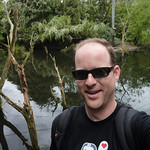|
If you're still here and reading, thanks! This is one of my outlets during the pandemic, much like the tank. For those who didn't read the first few posts, this is my first attempt at a planted tank. I'm not going to call it an aquascape, though I may use the term aquascaping for keeping the plants alive through maintenance. I'm not creating a replica of nature in a glass cube. I'm creating a fish tank with live plants. First, I want to make the fish happy. Second, a planted tank can cut down on algae. Third, well I wanted to do something different this time. Wooooo are planted tanks different! A lot of the old adages from freshwater fish-only tanks are no longer applicable. I'm not going to bore you with the nitrogen cycle, there are videos for that. In short, fish eat food and create waste. The waste builds up in a tank and must be dealt with. Healthy aerobic and anaerobic bacteria can break these compounds down in well established tanks. Starter bacteria can help you with that, but it's not magical. The usual way of dealing with uneaten food and fish waste is frequent gravel vacuuming and water changes. The idea is that replacing the water on a regular basis and sucking up the muck will keep things clean...until the next session. For most people, they can't handle this. Even then, things can happen and you have mass die-offs. Ammonia is the most dangerous compound that can build up in fish-only tanks and kill off our slippery friends quickly. A few days of not watching things and uh-oh...floaters. Oh, and don't confuse the nitrate cycle with "cycling" a tank. Folks use the "cycling" term with what happens to the typical fish-only aquarium. That is, they setup a tank and everything is fine with a few fish. Diatoms (brown algae aka "brown snow") that appear after a few weeks, only to be crowded out by algae a bit later, folks then try everything to get stuff in balance, and eventually a few weeks/months after that, things finally establish a harmony. Along the way, many fish are lost. Planted tanks are...different. You still need to do big water changes when starting (bigger sometimes), but vacuuming the gravel isn't a thing. You have soil. It's hard to vacuum without sucking up the soil. Oh and all that stuff you want to get out? It's food for plants! Plants turn ammonia and nitrate into food. They take in CO2 and produce oxygen. Live plants complete the ecosystem for a low maintenance tropical aquarium. Fish provide fuel for plants, plants provide fuel for fish (oxygen and clean water). Plants do such a great job at keeping things clean, you'll often find no filters at all on a well established, well maintained, densely planted tank. The tricky thing is keeping the plant growing thing in balance. Plants need high light levels to grow properly. High lights can also trigger algae growth. Plants also need CO2 with photosynthesis to produce oxygen. We take CO2 for granted when growing plants outside of aquariums. We have too much of it in the air right? Bill Gates is trying to bury it all in rocks. In an aquarium, the amount of CO2 in water is about 1/30th the amount in the atmosphere. So now you need CO2 gear to diffuse the gas into the tank. But oh yeah, too much CO2 and you'll kill your fish. I almost did this. I was trying out a new CO2 reactor below the tank, and I didn't realize that the flow rate was too high (this thing is VERY effective). Luckily Remy was right there and said, "Hey dad, look at the tetras. They're doing something funny in the corner." I'm glad he was there because I was eyes-down below the aquarium looking at this reactor. The fish were at the top of the tank, gasping for oxygen (and air -- even those without a labyrinth). I immediately did a huge water change and pointed the filter output up, creating massive water ripples (to bring in more oxygen). The final toll was one panda cory, but I'm not sure that was actually from the CO2. I got it in a bad batch where the other compatriots died quickly -- one on the way home and the other within 24 hours. The LFS employee basically crushed them all while trying to catch them, the tank conditions were bad, and they had a bacterial/fungal growth on them. I couldn't see the growth because the store had very bad lighting. Pro tip, don't buy fish from a store that isn't lit up like Fenway Park. But back to the CO2. Now you have yet another thing to keep in balance...fuckin great. Big if, but if you can, then you can have an algae free/minimal tank with healthy, happy fish. The idea is that the larger organism (plants) out compete the algae for resources (CO2, light, nutrients). So how do you get there? Next post. For now, enjoy some random videos from the early stages. Trying to find an Amano for Dustin I can watch shrimp all day Pretty sure this fella was already sick when I got him. Don't think it was my accidental gassing.
Comments are closed.
|
AuthorA NOLA native just trying to get by. I live in San Francisco and work as a digital plumber for the joint that runs this thing. (Square/Weebly) Thoughts are mine, not my company's. Archives
May 2021
Categories
All
|







 RSS Feed
RSS Feed